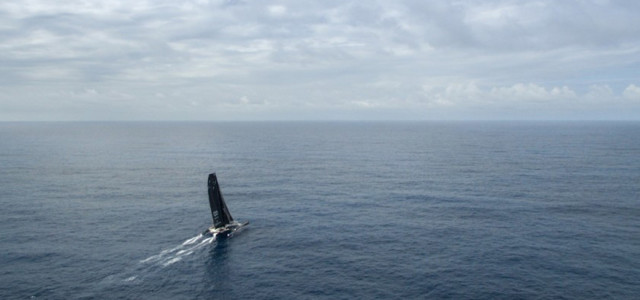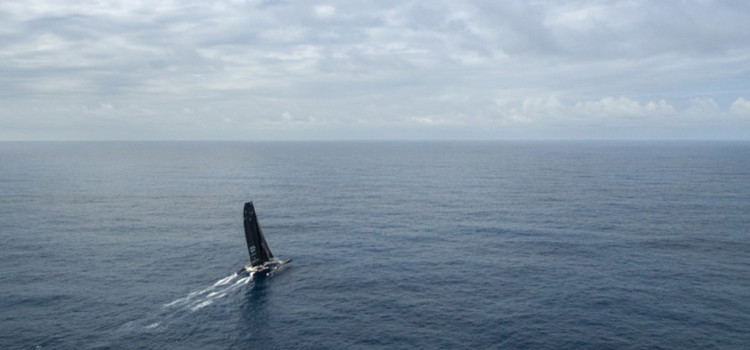

Jules Verne Trophy, the final ascent
EnglishIn evidenzaMultiscafiOceanoSpindrift 2Trofeo Jules VerneVela 2 Gennaio 2016 Zerogradinord 0

Equator – After crossing the line separating the hemispheres on December 31 at 17:33 UTC/GMT, Spindrift 2 is 1 day 10 hours 46 minutes and 550 miles behind the holder of the Jules Verne Trophy. But with 3,200 miles to go until the finish line in front of the Ushant lighthouse, the trimaran led by Dona Bertarelli, Yann Guichard and their 12 teammates is holding on to the goal of finishing in less than 45 days 13 hours 42 minutes 53 seconds, the record to beat for sailing around the world.
The South Atlantic was not accommodating for the crew of Spindrift 2, who faced more than 4,000 miles of listless and contrary wind, fickle breezes and stormy squalls, and chaotic seas and choppy waves. It was these difficult seas that caused a slight compression of the mast that the crew had to repair while sailing on, significantly slowing their progress for a few critical hours. And although the black and gold trimaran had a lead of 18 hours 11 minutes (and more than 500 miles) on the record time when rounding Cape Horn, these adverse conditions have still carried them to the Equator in 39 days 13 hours 31 minutes, which is 1 day 10 hours 46 minutes more than Banque Populaire V in 2012.
A 22-knot average required
Despite all the recent difficulties, the final sprint to the Créac’h lighthouse, which symbolises the end of this round-the-world voyage, remains on, since the average speed needed for reaching Ushant in time to beat the record is just over 22 knots over the 6 days, which are ticking away after crossing the Equator. Since leaving Ushant on November 22 at 05:01:58 UTC/GMT, Spindrift 2 has achieved an average over the water of more than 25 knots. However, the weather conditions in the North Atlantic are not exceptionally favourable, since the Azores High is spread over the optimal path towards Brittany. But from January 1, Yann Guichard, Dona Bertarelli and their 12 teammates will accelerate significantly in the north-easterly trade winds that will bring averages of over 30 knots.
So, the weekend will decide whether they have a chance of crossing the finish line fast enough to break the round-the-world record (45 days 13 hours 42 minutes 53 seconds), a time Spindrift 2 must beat by at least one minute for it to be valid; that is, before Wednesday, January 6 at 16:43:51 UTC/GMT. But in order to do this, the crew will have to cross the high-pressure system spread out off the Canary Islands, a narrow and tricky passage of about 250 miles, where the breeze promises to be weak. It is this crucial half a day that could allow the trimaran to cling onto the powerful westerly wind that is sweeping the North Atlantic, from Florida to Scandinavia
“Doubt is a tribute repaid by hope” Lautréamont
Once they reach the latitude of 33° North, a series of depressions will generate winds of over 30 knots until the tip of Brittany. And it could even be so strong that the heavy weather and rough seas that have been prevailing around Ushant for days will require great vigilance. In short, the suspense is likely to last until the final few miles of this unusual circumnavigation, which has already alternated for almost 40 days, between incredible accelerations and surprising decelerations, straining the minds and bodies of a crew, who have never given up, even during their sea of misfortunes.
And if doubts about the crossing of the Azores High float through their minds, they do not stay their long, because although meteorology is a science, it includes a percentage of uncertainty in relation to microclimates, which dot every cloud, every variation in barometric pressure, every contour in an isobar, and every ounce of air. There is strength in recognising the need for patience before making a decision but “for the brave of heart, nothing is impossible.”
Yann Guichard, just before crossing the Equator: “I think there must only be a few people who’ve spent the last few hours before a new year crossing the Equator. It’s a pretty nice symbolic moment. We’re going to open a half bottle of champagne, but with the offerings to Aeolus, Neptune and the boat, there won’t be more than a sip for each crew member (14…It was packed for the crossing of the Equator, but we’re going to kill two birds with one stone for the New Year too. And crossing the line (between the two hemispheres) in less than 40 days is also really great.”
“We’re going to enter a stormy area that will mark the end of the Doldrums (an area of light winds around the Equator): so we’ll be manoeuvring quite a lot at the start of the night to reach the north-east trade winds. After that, the record is mathematically possible, and sportingly too: the cut-off point will be the Azores High. We’ll have to do the most direct route possible without slowing down too much crossing the area of high pressure. We’re fortunate that the anticyclone is quite subdued and flat, resulting in some good trade winds, although the sea will be against us a little. The record time could be decided by a thin margin.”
“The South Atlantic has been hard for the whole crew as we lost roughly 1,000 miles: that’s a lot. And besides losing time, it was uncomfortable and boat-breaking weather, with the contrary wind and the sea against us; it was tiring, exhausting and we’ve not really been able to sleep because we were flying out of our bunks. It’s been better for the last two days, except that it’s now scorchingly hot inside. Anyway, we’re all super motivated for this final stretch. And the boat is in perfect condition: we made a last check-up before the Equator.”





No comments so far.
Be first to leave comment below.